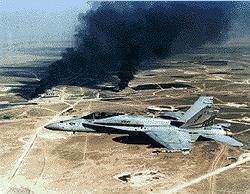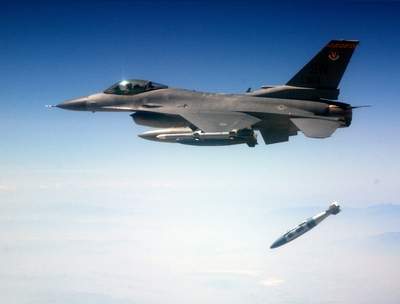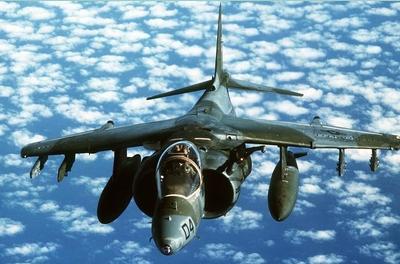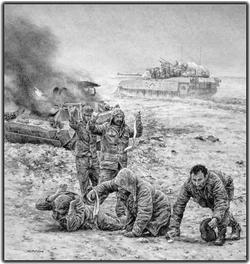Massive, Sustained, Combined-Forces Attack In Iraq
 If the Bush administration gets its way, the
United States will once again be at war with Iraq before the end of
the month. The air campaign in this Second Gulf War will be much
different than the 43-day long air campaign in 1991. It will be
much more foreceful, much more precise and will coincide with the
launching of ground operations. The combined effect on Iraq's
political and military leadership: "Shock and awe"
If the Bush administration gets its way, the
United States will once again be at war with Iraq before the end of
the month. The air campaign in this Second Gulf War will be much
different than the 43-day long air campaign in 1991. It will be
much more foreceful, much more precise and will coincide with the
launching of ground operations. The combined effect on Iraq's
political and military leadership: "Shock and awe"
More Than A Name
 The concept of "shock and awe" is actually
military doctrine at the Pentagon. The man who wrote it is Dr.
Harland Ullman at the Center for Strategic and International
Studies in Washington (DC).
The concept of "shock and awe" is actually
military doctrine at the Pentagon. The man who wrote it is Dr.
Harland Ullman at the Center for Strategic and International
Studies in Washington (DC).
"The notion here is that we want to affect, influence and
control both the will and perception of the Iraqi political and
military leadership to get them to do what we want them to do" -
which is to surrender en masse and give up dictator Saddam Hussein.
"The way to do that is to just impose on the Iraqi political and
military leadership a condition of complete hopelessness, where
they are so surrounded, so outgunned, so outnumbered that their
only option is to quit. We now have the technology and the
intellectual smarts to do that."
Indeed, the United States has amassed a huge military force in
the Persian Gulf. Six aircraft carrier battle groups are in the
Gulf, along with the British group centered on the HMS Ark
Royal.
Hundreds of allied warplanes are now based in Qatar, Bahrain,
Saudi Arabia and elsewhere. More than 250,000 American and British
troops are on the ground, pointed at Baghdad and ready to
fight.
Weapons Not Different - Just More Of Them
 The number of precision aerial weapons, whether
missiles or aircraft-delivered guided munitions, is staggering,
compared to the last Gulf War a dozen years ago. The United States
plans to deliver up to 3,000 of these missiles and bombs on Baghdad
in the very first few seconds of the conflict.
The number of precision aerial weapons, whether
missiles or aircraft-delivered guided munitions, is staggering,
compared to the last Gulf War a dozen years ago. The United States
plans to deliver up to 3,000 of these missiles and bombs on Baghdad
in the very first few seconds of the conflict.
"What we have here is the opportunity to employ thousands of
weapons against specific targets close to simultaneously. They'll
destroy only those targets instead of causing a lot of damage
around them.
"We have extraordinary precision here," said Dr. Ullman. "In
this campaign, it'll take one or two weapons to destroy a target,
where, in the old days, it would have taken 50 or 60. Even in the
Gulf War, we only had 10 percent smart weapons."
 The United States has also become much more adept
at precision targeting, said Ullman.
The United States has also become much more adept
at precision targeting, said Ullman.
"Go back to World War II," he said, in a telephone interview
with the USA Radio Network, "say you wanted to destroy a German
power plant. We'd send in, literally, hundreds of B-17s. They'd
drop thousands of bombs and we'd demolish everything. Now, because
we know a lot more, we realize that a power plant is very
vulnerable (to the destruction of) either a transformer or a
particular set of power lines or a control room. So, if you destroy
the transformer, the power lines or the control room, in essence,
you've destroyed the power plant - without having to destroy (the
entire) power plant."
Aerial Jujitsu
That same targeting analysis has been applied to the Iraqi Army
and particularly to the Iraqi Republican Guard, Saddam Hussein's
elite military force. "You really focus on the minimum pressure
points. This is a kind of jujitsu. If you take out those pressure
points and render (the Iraqis) impotent or incapable of operating,
in essence, you have made that part of the Iraqi Army impotent. You
put the Iraqis in a position of desperation. So much so,
psychologically that the only option they can consider is to
quit."

Note the concept of bringing about the collapse of Saddam's
forces without actually destroying them. "There is a moral
imperative, and we have embraced this, to minimize casualties. I'm
a veteran and a victim of the Vietnam war where we never did that.
The legacy is that we really appreciate now the need for minimum
casualties on our side - and certainly civilian casualties. So this
is going to be one of the requirements for planning: 'How can we do
this as - antiseptically is a bad word - as efficiently as possible
to minimize casualties on all sides."
That idea seems to bear upon "life after Saddam." Supposing a
regime change, Ullman says, we're going to need the remnants of
Iraq's army to help restore and maintain order as the country
transitions from a dictatorship, to military rule, and then to
self-elected civilian rule. "Besides," said Ullman, "if we destroy
the Iraqi army on a wholesale basis hoping to demoralize them, it
might just have the opposite effect. So the notion here is to hold
them wholly vulnerable without necessarily having to kill or attack
them, because that generates the strongest psychological force that
will cause them to do our will and to surrender with a minimum of
fighting on their side."

More Than Smart Bombs
 Dr. Ullman said the initial campaign of "shock and
awe" will come, not just from above, but on the ground as well.
"It's not just launching weapons on targets. It's the simultaneous
use of ground forces, of psychological warfare and information
operations, so that all of a sudden, the enemy feels entirely
hopeless and impotent. They'll feel that American forces are on the
ground everywhere and nowhere. They'll know we're there, they'll
know we're doing things to them, but they won't know where we are.
The use of these munitions, whether they're cruise missiles or JDAM
stand-off munitions in large quantities - the simultaneous nature
of these attacks against specific targets, with great precision,
will impose upon the Iraqis the sense of hopelessness. We hope this
will lead them to surrender."
Dr. Ullman said the initial campaign of "shock and
awe" will come, not just from above, but on the ground as well.
"It's not just launching weapons on targets. It's the simultaneous
use of ground forces, of psychological warfare and information
operations, so that all of a sudden, the enemy feels entirely
hopeless and impotent. They'll feel that American forces are on the
ground everywhere and nowhere. They'll know we're there, they'll
know we're doing things to them, but they won't know where we are.
The use of these munitions, whether they're cruise missiles or JDAM
stand-off munitions in large quantities - the simultaneous nature
of these attacks against specific targets, with great precision,
will impose upon the Iraqis the sense of hopelessness. We hope this
will lead them to surrender."
Aerial bombardment, however, will be the key to "shock and awe."
Ullman uses the example of Hiroshima and Nagasaki. At the end of
the Second World War, the United States faced the daunting
likelihood of invading Japan to force them to surrender. Instead,
the United States deployed the first - and so far, the only -
nuclear weapons ever fired in anger. "The notion here of 'shock and
awe' is that we changed the will and perception of an enemy that,
prior to the bombings, was suicidal. We did it because we shocked
them and awed them. Basically, the Japanese could not understand
that one airplane, one bomb, could have that destructive
power."
 It is, Ullman admitted, something of a gamble.
Just as the Japanese might have chosen to fight on in spite of
Hiroshima and Nagasaki, the Iraqis, he said, could decide they're
just not that impressed with the "shock and awe" doctrine. "This
may be the most brilliantly executed military strategy," Ullman
said. "It may do all the things that we've hoped. The Iraqis may
decide that they're not going to tolerate an invasion, that they
will retreat to Baghdad and there'll be a horrible battle around
Baghdad. That could happen. In wartime, you have to plan for the
worst, but hope for the best. There's no guarantee in war. Things
could go very badly."
It is, Ullman admitted, something of a gamble.
Just as the Japanese might have chosen to fight on in spite of
Hiroshima and Nagasaki, the Iraqis, he said, could decide they're
just not that impressed with the "shock and awe" doctrine. "This
may be the most brilliantly executed military strategy," Ullman
said. "It may do all the things that we've hoped. The Iraqis may
decide that they're not going to tolerate an invasion, that they
will retreat to Baghdad and there'll be a horrible battle around
Baghdad. That could happen. In wartime, you have to plan for the
worst, but hope for the best. There's no guarantee in war. Things
could go very badly."
Even so, Ullman said, "shock and awe" is still a viable plan of
battle. "If we're looking to win this in the quickest, most
decisive possible way, with minimum casualties, this offers us the
best alternative. But we have to understand that war is a bloody,
dangerous, nasty business where things go wrong. I've been there.
I've experienced that. This could happen (in Iraq). We have to plan
for the worst and hope for the best."
ANN Weekend Editor Pete Combs conducted his interview with
Dr. Ullman for his award-winning daily news program "America
United: The War on Terror," a service of the USA Radio
Network.
 ANN's Daily Aero-Linx (04.15.24)
ANN's Daily Aero-Linx (04.15.24) Classic Aero-TV: 'No Other Options' -- The Israeli Air Force's Danny Shapira
Classic Aero-TV: 'No Other Options' -- The Israeli Air Force's Danny Shapira Aero-News: Quote of the Day (04.15.24)
Aero-News: Quote of the Day (04.15.24) Airborne 04.16.24: RV Update, Affordable Flying Expo, Diamond Lil
Airborne 04.16.24: RV Update, Affordable Flying Expo, Diamond Lil ANN's Daily Aero-Term (04.16.24): Chart Supplement US
ANN's Daily Aero-Term (04.16.24): Chart Supplement US










